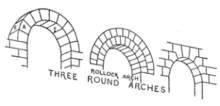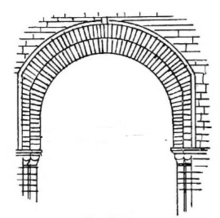
Semicircular arch is an arch with intrados (inner surface) shaped like a semicircle. [1] [2] This type of arch was adopted and very widely used by the Romans, thus becoming permanently associated with the Roman architecture. [3]
Terminology
When the arch construction involves the Roman techniques (either wedge-like stone voussoirs or thin Roman bricks), it is known as a Roman arch. [4] The semicircular arch is also known as a round arch. [5] [6]
Description

The rise (height) of a round arch is limited to 1⁄2 of its span, [7] so it looks more "grounded" than a parabolic arch [3] or a pointed arch. [7] Whenever a higher semicircular arch was required (for example, for a narrow arch to match the height of a nearby broad one), either stilting or horseshoe shape were used, thus creating a stilted arch (also surmounted [8]) and horseshoe arch respectively. [9] These "shifts and dodges" were immediately dropped once the pointed arch with its malleable proportions was adopted. [7] Still, "the Romanesque arch is beautiful as an abstract line. Its type is always before us in that of the apparent vault of heaven, and horizon of the earth" ( John Ruskin, " The Seven Lamps of Architecture"). [10]
When the architecture of the building dictates the rise of he arch to be less that 1⁄2 of its span (for example, in Roman residential construction), a segmental arch with a rounded shape that is less than a semicircle can be used. [11]
History and associated styles
The popularity of the semicircular arch is based on simplicity of its layout and construction, [12] not superior structural properties. The sides of this arch swing wider than the perfect funicular curve and therefore experience a bending moment with the force directed outwards. [13] To prevent buckling, heavy surcharge (fill), so called spandrel, needs to be applied outside of the haunches. [12]
In addition to the Imperial Roman construction, round arches are also associated with Byzantine, Romanesque (and Neo-Romanesque), Renaissance [14] and Rundbogenstil styles. While the semicircular arch was known in the Greek architecture, it mostly played there a decorative, not structural, role. [15]
Gallery
References
- ^ Oxford University Press 2006a.
- ^ Kurtz 2007, p. 34.
- ^ a b Sandaker, Eggen & Cruvellier 2019, p. 445.
- ^ Oxford University Press 2006b.
- ^ Oxford University Press 2006c.
- ^ Sturgis & Davis 2013, p. 112.
- ^ a b c Bond 1905, p. 265.
- ^ "surmounted arch". Merriam-Webster.com Dictionary.
- ^ Bond 1905, p. 262.
- ^ Bond 1905, p. 261.
- ^ DeLaine 1990, p. 417.
- ^ a b Mark 1996, p. 387.
- ^ Sandaker, Eggen & Cruvellier 2019, p. 464.
- ^ Sturgis & Davis 2013, p. 115.
- ^ DeLaine 1990, p. 412.
Sources
- "semicircular arch". A Dictionary of Architecture and Landscape Architecture. Oxford University Press. 2006a. doi: 10.1093/acref/9780198606789.001.0001. ISBN 978-0-19-860678-9.
- "Roman arch". A Dictionary of Architecture and Landscape Architecture. Oxford University Press. 2006b. doi: 10.1093/acref/9780198606789.001.0001. ISBN 978-0-19-860678-9.
- "round". A Dictionary of Architecture and Landscape Architecture. Oxford University Press. 2006c. doi: 10.1093/acref/9780198606789.001.0001. ISBN 978-0-19-860678-9.
- Sandaker, B.N.; Eggen, A.P.; Cruvellier, M.R. (2019). The Structural Basis of Architecture. Taylor & Francis. ISBN 978-1-317-22918-6. Retrieved 2023-12-15.
- Sturgis, Russell; Davis, Francis A. (2013). "Round Arch". Sturgis' Illustrated Dictionary of Architecture and Building: An Unabridged Reprint of the 1901-2 Edition. Dover Architecture. Dover Publications. ISBN 978-0-486-14840-3. Retrieved 2023-12-15.
- Bond, Francis (1905). Gothic Architecture in England: An Analysis of the Origin & Development of English Church Architecture from the Norman Conquest to the Dissolution of the Monasteries. Collections spéciales. B. T. Batsford. Retrieved 2023-12-15.
- DeLaine, Janet (1990). "Structural experimentation: The lintel arch, corbel and tie in western Roman architecture". World Archaeology. 21 (3): 407–424. doi: 10.1080/00438243.1990.9980116. ISSN 0043-8243.
- Mark, Robert (July–August 1996). "Architecture and Evolution" (PDF). American Scientist. 84 (4). Sigma Xi, The Scientific Research Honor Society: 383–389. JSTOR 29775710.
- Kurtz, J.P. (2007). Dictionary of Civil Engineering: English-French. EngineeringPro collection. Springer US. ISBN 978-0-306-48474-2. Retrieved 2024-01-01.

Semicircular arch is an arch with intrados (inner surface) shaped like a semicircle. [1] [2] This type of arch was adopted and very widely used by the Romans, thus becoming permanently associated with the Roman architecture. [3]
Terminology
When the arch construction involves the Roman techniques (either wedge-like stone voussoirs or thin Roman bricks), it is known as a Roman arch. [4] The semicircular arch is also known as a round arch. [5] [6]
Description

The rise (height) of a round arch is limited to 1⁄2 of its span, [7] so it looks more "grounded" than a parabolic arch [3] or a pointed arch. [7] Whenever a higher semicircular arch was required (for example, for a narrow arch to match the height of a nearby broad one), either stilting or horseshoe shape were used, thus creating a stilted arch (also surmounted [8]) and horseshoe arch respectively. [9] These "shifts and dodges" were immediately dropped once the pointed arch with its malleable proportions was adopted. [7] Still, "the Romanesque arch is beautiful as an abstract line. Its type is always before us in that of the apparent vault of heaven, and horizon of the earth" ( John Ruskin, " The Seven Lamps of Architecture"). [10]
When the architecture of the building dictates the rise of he arch to be less that 1⁄2 of its span (for example, in Roman residential construction), a segmental arch with a rounded shape that is less than a semicircle can be used. [11]
History and associated styles
The popularity of the semicircular arch is based on simplicity of its layout and construction, [12] not superior structural properties. The sides of this arch swing wider than the perfect funicular curve and therefore experience a bending moment with the force directed outwards. [13] To prevent buckling, heavy surcharge (fill), so called spandrel, needs to be applied outside of the haunches. [12]
In addition to the Imperial Roman construction, round arches are also associated with Byzantine, Romanesque (and Neo-Romanesque), Renaissance [14] and Rundbogenstil styles. While the semicircular arch was known in the Greek architecture, it mostly played there a decorative, not structural, role. [15]
Gallery
References
- ^ Oxford University Press 2006a.
- ^ Kurtz 2007, p. 34.
- ^ a b Sandaker, Eggen & Cruvellier 2019, p. 445.
- ^ Oxford University Press 2006b.
- ^ Oxford University Press 2006c.
- ^ Sturgis & Davis 2013, p. 112.
- ^ a b c Bond 1905, p. 265.
- ^ "surmounted arch". Merriam-Webster.com Dictionary.
- ^ Bond 1905, p. 262.
- ^ Bond 1905, p. 261.
- ^ DeLaine 1990, p. 417.
- ^ a b Mark 1996, p. 387.
- ^ Sandaker, Eggen & Cruvellier 2019, p. 464.
- ^ Sturgis & Davis 2013, p. 115.
- ^ DeLaine 1990, p. 412.
Sources
- "semicircular arch". A Dictionary of Architecture and Landscape Architecture. Oxford University Press. 2006a. doi: 10.1093/acref/9780198606789.001.0001. ISBN 978-0-19-860678-9.
- "Roman arch". A Dictionary of Architecture and Landscape Architecture. Oxford University Press. 2006b. doi: 10.1093/acref/9780198606789.001.0001. ISBN 978-0-19-860678-9.
- "round". A Dictionary of Architecture and Landscape Architecture. Oxford University Press. 2006c. doi: 10.1093/acref/9780198606789.001.0001. ISBN 978-0-19-860678-9.
- Sandaker, B.N.; Eggen, A.P.; Cruvellier, M.R. (2019). The Structural Basis of Architecture. Taylor & Francis. ISBN 978-1-317-22918-6. Retrieved 2023-12-15.
- Sturgis, Russell; Davis, Francis A. (2013). "Round Arch". Sturgis' Illustrated Dictionary of Architecture and Building: An Unabridged Reprint of the 1901-2 Edition. Dover Architecture. Dover Publications. ISBN 978-0-486-14840-3. Retrieved 2023-12-15.
- Bond, Francis (1905). Gothic Architecture in England: An Analysis of the Origin & Development of English Church Architecture from the Norman Conquest to the Dissolution of the Monasteries. Collections spéciales. B. T. Batsford. Retrieved 2023-12-15.
- DeLaine, Janet (1990). "Structural experimentation: The lintel arch, corbel and tie in western Roman architecture". World Archaeology. 21 (3): 407–424. doi: 10.1080/00438243.1990.9980116. ISSN 0043-8243.
- Mark, Robert (July–August 1996). "Architecture and Evolution" (PDF). American Scientist. 84 (4). Sigma Xi, The Scientific Research Honor Society: 383–389. JSTOR 29775710.
- Kurtz, J.P. (2007). Dictionary of Civil Engineering: English-French. EngineeringPro collection. Springer US. ISBN 978-0-306-48474-2. Retrieved 2024-01-01.






